This was published 1 year ago
These men watched a croc kill their friend. Australia doesn’t know, and he’s not the first
Faced with diminished fish stocks and what they say are outdated Australian government policies, Indonesian fishermen are risking everything.
By Zach Hope and Amilia Rosa
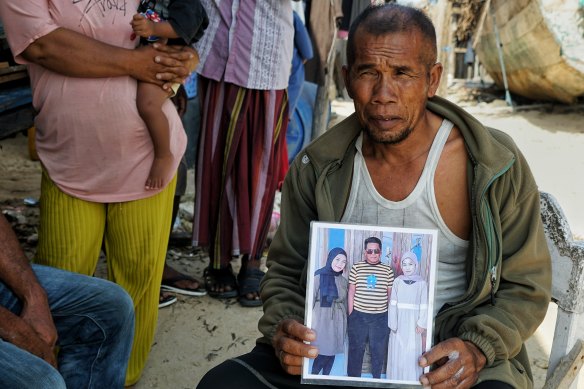
Syafudin M with a picture of his dead cousin, Laudi (centre).Credit: Amilia Rosa
The Western Australian government doesn’t know how many people have been killed by crocodiles in its warm, northern waters. Kasim Djalilan, a sea-gnarled fisherman from Indonesia’s West Timor province, could tell them of at least four since 2020. He saw one himself only last year.
The 33-year-old with a family to feed is among a wave of Indonesian boatmen reaching the Australian mainland with almost comical ease against the touted might of Operation Sovereign Borders. More than a dozen times he has picked through the Kimberley mangroves for sea cucumber, also called trepang; a curious slug-like creature highly valued in China for its purported medicinal miracles.
The trepangers explain they use offline Google Maps to navigate from Indonesia. The more diligent among them, like the fishermen-turned-smugglers who dumped two loads of would-be immigrants in WA this year, study the Australian Border Force and know its drone ploys “by heart”.
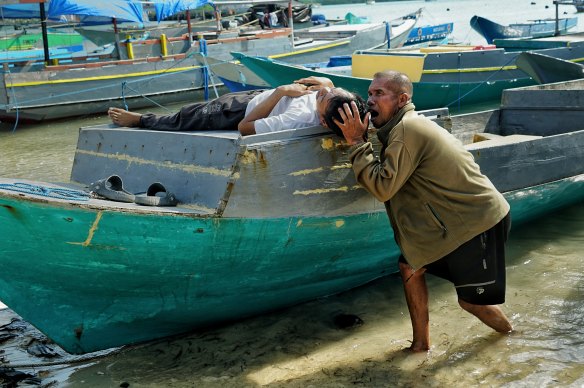
Papela fishermen demonstrate how Laudi was taken by a crocodile.Credit: Amilia Rosa
“If it’s Thursday, they will fly this hour. If it’s Wednesday, they will fly this hour,” he says. “We wait it out, and we sneak in.”
It was on one of these familiar sneak-ins that his friend, Laudi, a 30-year-old father and husband, died at a Kimberley inlet too remote for a European name.
This masthead meets Laudi’s colleagues at their Rote Island village of Papela for a grim re-enactment. Kasim plays the part of Laudi, lying flat on his back atop a moored trepang boat. The dead man’s cousin assumes the role of “alligator”.
Laudi is sleeping, his head only slightly poking over the water, and the crocodile is gliding steadily and unseen until in range it launches its upper body from the water, latching onto Laudi’s skull and flipping him into the foaming water.
The body eventually floats to the surface, allowing the men to retrieve it for a burial in front of the family.
The fishermen speak of three other crocodile attack deaths and a serious injury in Australia, all of them unknown to coroners, police or the public.
Laudi’s story is one of the more horrific relayed during this masthead’s visit to Papela as part of an investigation spanning multiple Indonesian islands, and the homes and offices of dozens of fishermen, people smugglers and government sources, into rising numbers of sailors entering Australian territory, sometimes with illegal human cargo.
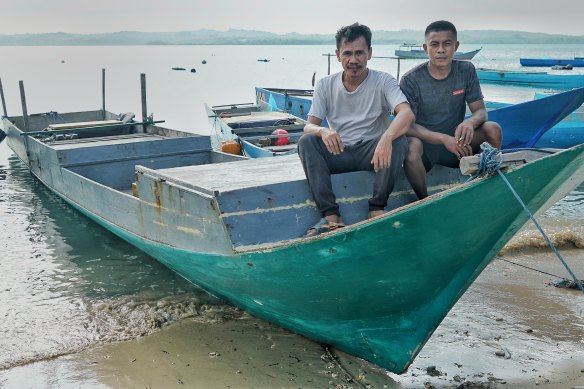
Trepang men Kasim (left) and Renaldy on a boat used to reach the Australian mainland. Credit: Amilia Rosa
While the true number of successful trepang runs to the Australian mainland is unknowable, anecdotal evidence suggests it is staggering.
On the minuscule Maginti Island in South-East Sulawesi province, a village boss acknowledges most of his fishermen are regularly cruising for Australia. “It’s not about breaking the law, it’s simply because they need to make a living,” Ali Imron says.
Sailors from Makassar harvested sea cucumbers from northern Australian coastlines long before European settlement and until early last century, forming relationships with Aboriginal nations along the way. The Yolngu people of north-east Arnhem Land still call white people “balanda”, a version of the Indonesian word for Dutchman.
In early 2020, according to the Rote Island men, an illegal Sulawesi crew made a shocking discovery after straying to the Australian mainland in strong winds: trepang, plump, plentiful and far more valuable than the smaller Indonesian variety. All they had to do was bend down and pick them up from the shallows.
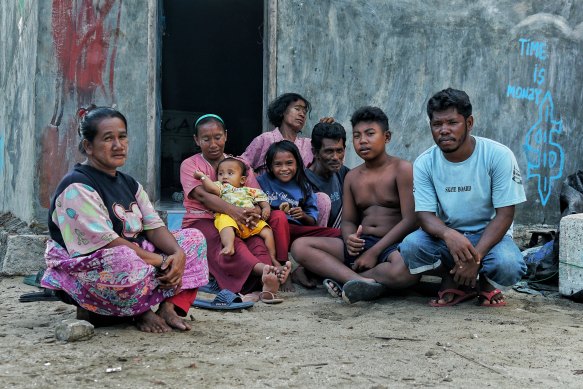
Magas (right) with his family in the Rote Island village of Papela. “I have been to Australia more than 20 times, and not once caught,” he says. Credit: Amilia Rosa
The news triggered a kind of maritime gold rush, fuelled by an assumption among the fishermen that, even if they were caught, the Australians would be reluctant to haul them ashore amid the nascent COVID pandemic.
“There is just an abundance of trepang there and no one [in Australia] is collecting it,” says Dahlan Karabi, a Papela fisherman and multi-time former people smuggler. “Everybody started putting bigger engines into their boats to get them out there faster”.
Back in his day ferrying asylum seekers to Australia, the boats went at about four knots. The trepang vessels can go four or five times that, he says. They are easy to pick for their compact size and arrow head-like shape. The owners paint them grey or green to blend in with the ocean or mangroves.
The village of Papela, on the eastern side of Rote Island, is a 10-or-so hour cruise to Australia in a decent trepang craft. Its small harbour is dotted with them.
One is owned by Kasim, who, though mostly successful in his runs to Australia, has been caught five times, spending short periods in Australian jail. He was turned home twice during the pandemic without punishment.
Other than Laudi’s tragic death, his most heartbreaking moment was when arresting ABF officers, in line with Australian policy, threw the equivalent of a year’s wage worth of trepang overboard and then burnt his boat at sea.
When the weather clears, he will need to pay off his new vessel with more trips to Australia, he says. He does not rule out taking paying passengers.
“It depends on the money,” he says. “We would want a minimum of 150 million rupiah [about $14,000]. If not, no go. But it’s a risk that I am willing to take to provide for my family.”
When the ABF discovers an Indonesian boat empty of fish but straying into Australian territory, officers will cruise up and hand out a paper map with information about where the crew can and cannot fish.
A small case study in Australian bureaucracy: it is printed entirely in English.
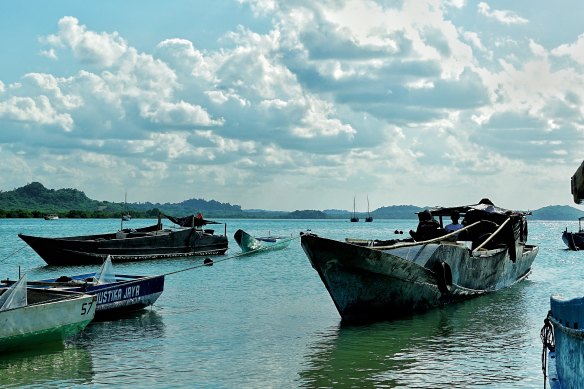
Maginti Island-style trepang boats moored in Papela’s harbour. Credit: Amilia Rosa
Only one of the men gathered in Dahlan’s living room to speak with this masthead about their troubles can make sense of the words. The 60-year-old host picked up some English while serving more than four years in various Australian prisons for people smuggling more than a decade ago.
Back then, smugglers would try to drop-and-dash at Ashmore Reef, which is closer to Indonesia than Western Australia. Now, with the knowledge and the boats of the new generation, reaching the mainland is not only feasible for people smugglers but has already been achieved at least twice this year: first, in February, with a regular fishing vessel captained by trepang man; and again, in early April, with two trepang boats.
Days after the April run, the old people smuggler took a call from a Jakarta-based contact.
“He told me there was a successful dropping-off in Australia,” he says. “This agent said, ‘Can you do it? Can you arrange one?’ I said no. The risk is too high. Australia knows about me. Indonesian fisheries know about me. Even though I was the one doing the dangerous work, it was my family who were going to pay for that.”
Dahlan sticks to traditional fishing these days, meaning he uses a sailboat without an engine. The old-school method is the only legal way to move inside what is called the “Memorandum of Understanding Box”, a patch of Australian waters near the maritime boundary that recognises Indonesians’ generations-old fishing claims.

Dahlan, former people smuggler and present-day struggling fisherman. Credit: Amilia Rosa
But without engines, the cross-border fishermen are at the mercy of the winds, leading to hundreds of deaths on MOU Box reefs this century alone, he says.
“I asked [Australian officials] if they can upgrade the terms of traditional boat to include an engine,” he says. “In traditional boats, we cannot reverse. Australia rejected the request.”
For Dahlan and his friends, the response was a deadly and narrow-minded conflation of “traditional” with “backwardness”. A marine biologist, speaking on condition of anonymity to comment without approval from their organisation, warns species would suffer if the terms were updated.
For its part, the Australia Fisheries Management Authority could not point to any data it uses to assess MOU Box fishing, or to a single study about the potential flow-on effects should the rules be changed.
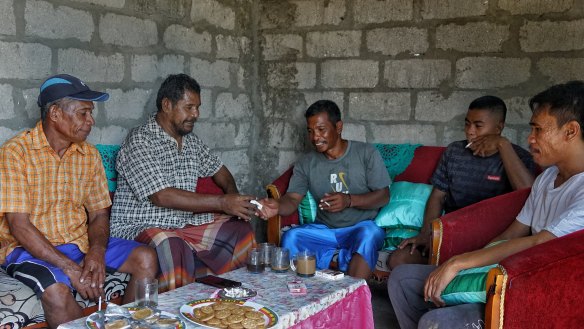
The fishermen gathered in Dahlan’s Papela home to share their troubles with this masthead. Credit: Amilia Rosa
The fishermen’s concerns beg an obvious question: why not stay in Indonesian waters?
“Yes!” Dahlan exclaims, leaning forward and dragging on his cigarette. “That’s the one I’ve been waiting for.
“That Montara oil spill, we are victims of that. There are no more fish. Everyone has to go further [out to sea].”
One of Australia’s worst man-made disasters, the 2009 spill off the coast of WA ruined coastal Indonesian villages caught in the oil’s drift. In 2021, the Australian Federal Court ordered compensation for seaweed farmers, but fishermen were not included in the class action.
“Their losses were greater than the seaweed farmers, I’ve got no doubt about that,” says lawyer Greg Phelps, who represented the victims in court. “I would have loved to have brought a class action for them, but we obviously had commercial pressure about what would work and what wouldn’t.”
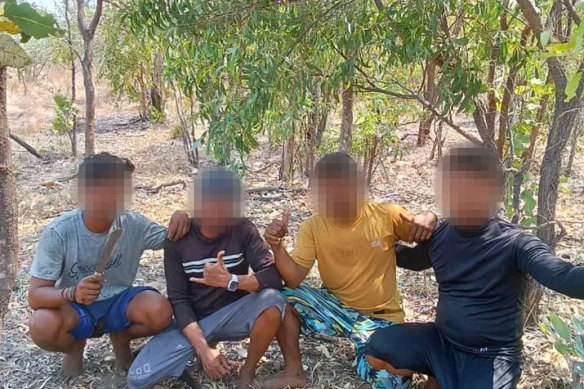
Indonesian trepang men pose for a photo in Australia.
He explains how the seaweed farmers could prove a form of ownership over their stationary plots. This was not possible for the fishermen. For the class action to succeed, it had to be narrowly focused, he says.
With the state of fish stocks off Papela and Australia’s stubbornness over the MOU Box, Dahlan, Kasim and the other fishermen say more trepang runs and people smuggling attempts are inevitable.
“I tell [the Australians], maybe I go back to my old job: smuggling,” says the host, switching to English to make sure this masthead understands.
“I know this wrong. I break this law. But it’s my family. You see now?”
Get a note directly from our foreign correspondents on what’s making headlines around the world. Sign up for the weekly What in the World newsletter here.